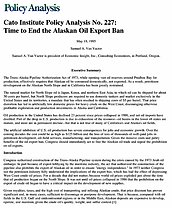The natural market for North Slope oil is Japan, Korea, and northern East Asia, to which oil can be shipped for about 50 cents per barrel, but North Slope producers are required to use domestic tankers and market exclusively in the United States and its territories, a mandate that has often resulted in shipping costs of $5 per barrel. That price distortion has led to artificially low domestic prices for heavy crude on the West Coast, discouraging otherwise profitable exploration and production investments in Alaska and California.
Oil production in the United States has declined 23 percent since prices collapsed in 1986, and net oil imports have doubled. Part of the drop in U.S. production is due to exhaustion of the resource–oil basins in the lower 48 states are mature, and most are in permanent decline–but that is not true of many of California’s and Alaska’s oil fields.
The artificial inhibition of U.S. oil production has severe consequences for jobs and economic growth. Over the coming decades the cost could be as high as $125 billion and the loss of tens of thousands of well-paid jobs in petroleum development, oil-field services, manufacturing, and transportation. Given the massive costs and paltry benefits of the oil export ban, Congress should immediately act to free the Alaskan oil trade and repeal the prohibition on oil exports.

